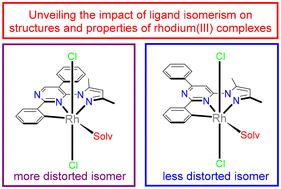当前位置:
X-MOL 学术
›
Dalton Trans.
›
论文详情
Our official English website, www.x-mol.net, welcomes your feedback! (Note: you will need to create a separate account there.)
N^N^C-Cyclometalated rhodium(III) complexes with isomeric pyrimidine-based ligands: unveiling the impact of isomerism on structural motifs, luminescence and cytotoxicity
Dalton Transactions ( IF 3.5 ) Pub Date : 2024-04-23 , DOI: 10.1039/d4dt00824c Sofia N. Vorobyeva 1 , Sof'ya A. Bautina 2 , Nikita A. Shekhovtsov 1 , Elena B. Nikolaenkova 3 , Taisiya S. Sukhikh 1 , Yuliya A. Golubeva 1 , Lyubov S. Klyushova 4 , Viktor P. Krivopalov 3 , Marianna I. Rakhmanova 1 , Christophe Gourlaouen 5 , Mark B. Bushuev 1
Dalton Transactions ( IF 3.5 ) Pub Date : 2024-04-23 , DOI: 10.1039/d4dt00824c Sofia N. Vorobyeva 1 , Sof'ya A. Bautina 2 , Nikita A. Shekhovtsov 1 , Elena B. Nikolaenkova 3 , Taisiya S. Sukhikh 1 , Yuliya A. Golubeva 1 , Lyubov S. Klyushova 4 , Viktor P. Krivopalov 3 , Marianna I. Rakhmanova 1 , Christophe Gourlaouen 5 , Mark B. Bushuev 1
Affiliation

|
The impact of isomerism of pyrimidine-based ligands and their rhodium(III) complexes with regard to their structures and properties was investigated. Two isomeric ligands, 4-(3,5-dimethyl-1H-pyrazol-1-yl)-2,5-diphenylpyrimidine (HL2,5) and 4-(3,5-dimethyl-1H-pyrazol-1-yl)-2,6-diphenylpyrimidine (HL2,6), were synthesized. The ligands differ by the degree of steric bulk: the molecular structure of HL2,5 is more distorted due to presence of pyrazolyl and phenyl groups in the neighbouring positions 4 and 5 of the pyrimidine ring. The complexation of HL2,5 and HL2,6 with RhCl3 leads to the sp2 C–H bond activation, resulting in the isolation of two complexes, [RhL2,5(Solv)Cl2]·nEtOH and [RhL2,6(Solv)Cl2]·nEtOH (Solv = H2O, EtOH), with the deprotonated forms of the pyrazolylpyrimidine molecules which coordinate the Rh3+ ion as N^N^C-tridentate ligands. According to DFT modelling, the mechanism of the deprotonation involves (i) the C–H bond breaking in the 2-phenyl group followed by the coordination of the C atom to the Rh atom, (ii) the protonation of coordinated chlorido ligand, (iii) the ejection of the HCl molecule and (iv) the coordination of the H2O molecule. The ligand isomerism has an impact on emission properties and cytotoxicity of the complexes. Although the excited states of the complexes effectively deactivate through S0/T1 and S0/S1 crossings associated with the cleavage of the weak H2O ligands upon excitation, the [RhL2,5(Solv)Cl2]·nEtOH complex appeared to be emissive in the solid state, while [RhL2,6(Solv)Cl2]·nEtOH is non-emissive at all. The complexes show significant cytotoxic activity against cancerous HepG2 and Hep2 cell lines, with the [RhL2,6(Solv)Cl2]·nEtOH complex being more active than its isomer [RhL2,5(Solv)Cl2]·nEtOH. On the other hand, noticeable cytotoxicity of the latter against HepG2 is supplemented by its non-toxicity against non-cancerous MRC-5 cells.
中文翻译:

N^N^C-环金属化铑(III)与异构嘧啶基配体的配合物:揭示异构现象对结构基序、发光和细胞毒性的影响
研究了嘧啶基配体及其铑( III )配合物的异构现象对其结构和性能的影响。两个异构配体,4-(3,5-二甲基-1 H -吡唑-1-基)-2,5-二苯基嘧啶 ( HL 2,5 ) 和 4-(3,5-二甲基-1 H -吡唑-1)合成了-yl)-2,6-二苯基嘧啶( HL 2,6 )。配体的空间体积程度有所不同:由于嘧啶环的相邻位置 4 和 5 上存在吡唑基和苯基,HL 2,5的分子结构更加扭曲。 HL 2,5和HL 2,6与 RhCl 3的络合导致 sp 2 C–H 键活化,从而分离出两个络合物:[RhL 2,5 (Solv)Cl 2 ]· n EtOH和[ RhL 2,6 (Solv)Cl 2 ]· n EtOH (Solv = H 2 O, EtOH),具有吡唑基嘧啶分子的去质子化形式,其将Rh 3+离子配位为N^N^C-三齿配体。根据DFT模型,去质子化的机制涉及(i)2-苯基中的C-H键断裂,然后C原子与Rh原子配位,(ii)配位氯配体的质子化,( iii) HCl 分子的喷射和(iv) H 2 O 分子的配位。配体异构现象对配合物的发射特性和细胞毒性有影响。尽管复合物的激发态通过与弱 H 2 O 配体在激发时裂解相关的S 0 /T 1和 S 0 /S 1交叉有效失活, [RhL 2,5 (Solv)Cl 2 ]· n EtOH络合物在固态下似乎具有发射性,而[RhL 2,6 (Solv)Cl 2 ]· n EtOH根本不具有发射性。该复合物对癌性 HepG2 和 Hep2 细胞系表现出显着的细胞毒活性,其中[RhL 2,6 (Solv)Cl 2 ]· n EtOH复合物比其异构体[RhL 2,5 (Solv)Cl 2 ]· n活性更高乙醇。另一方面,后者对 HepG2 的显着细胞毒性与其对非癌性 MRC-5 细胞的无毒性相补充。
更新日期:2024-04-23
中文翻译:

N^N^C-环金属化铑(III)与异构嘧啶基配体的配合物:揭示异构现象对结构基序、发光和细胞毒性的影响
研究了嘧啶基配体及其铑( III )配合物的异构现象对其结构和性能的影响。两个异构配体,4-(3,5-二甲基-1 H -吡唑-1-基)-2,5-二苯基嘧啶 ( HL 2,5 ) 和 4-(3,5-二甲基-1 H -吡唑-1)合成了-yl)-2,6-二苯基嘧啶( HL 2,6 )。配体的空间体积程度有所不同:由于嘧啶环的相邻位置 4 和 5 上存在吡唑基和苯基,HL 2,5的分子结构更加扭曲。 HL 2,5和HL 2,6与 RhCl 3的络合导致 sp 2 C–H 键活化,从而分离出两个络合物:[RhL 2,5 (Solv)Cl 2 ]· n EtOH和[ RhL 2,6 (Solv)Cl 2 ]· n EtOH (Solv = H 2 O, EtOH),具有吡唑基嘧啶分子的去质子化形式,其将Rh 3+离子配位为N^N^C-三齿配体。根据DFT模型,去质子化的机制涉及(i)2-苯基中的C-H键断裂,然后C原子与Rh原子配位,(ii)配位氯配体的质子化,( iii) HCl 分子的喷射和(iv) H 2 O 分子的配位。配体异构现象对配合物的发射特性和细胞毒性有影响。尽管复合物的激发态通过与弱 H 2 O 配体在激发时裂解相关的S 0 /T 1和 S 0 /S 1交叉有效失活, [RhL 2,5 (Solv)Cl 2 ]· n EtOH络合物在固态下似乎具有发射性,而[RhL 2,6 (Solv)Cl 2 ]· n EtOH根本不具有发射性。该复合物对癌性 HepG2 和 Hep2 细胞系表现出显着的细胞毒活性,其中[RhL 2,6 (Solv)Cl 2 ]· n EtOH复合物比其异构体[RhL 2,5 (Solv)Cl 2 ]· n活性更高乙醇。另一方面,后者对 HepG2 的显着细胞毒性与其对非癌性 MRC-5 细胞的无毒性相补充。






































 京公网安备 11010802027423号
京公网安备 11010802027423号